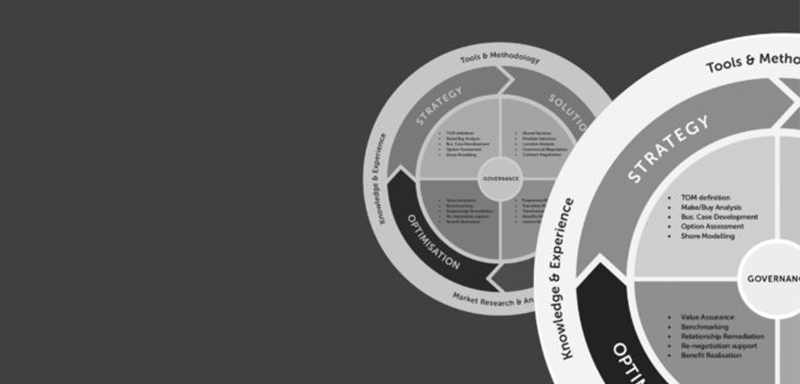
WE HELP OUR CLIENTS USE SHARED SERVICES TO DRIVE BENEFITS ACROSS THE BUSINESS ENTERPRISE.
Introduction to Shared Services
Organisations are continuing to recognise the Strategy value that Shared Services can deliver in terms of reducing costs, improving control, and service levels.
The concept of shared services is a simple one, the establishment of a capability that can deliver services that can be utilised by others within the wider business – typically different business units, countries, territories, or functions. By focusing the same (or similar) processes and services into one team this can then drive economies of scale, and drive improvement in the standardisation, simplification, and potential digitalisation of the processes such that they are cheaper, more efficient, more effective, and consistent in their provision for the benefit of the wider business. Simple.
Shared Services as a concept developed rapidly in the 1980s and 1990s focusing initially on low-value activities in Finance and IT functions but has progressed into HR, Procurement, Legal, and industry specific middle-office type activities (eg. actuarial, capital reserving), as well as moving much further up the value-chain within the functions. The original pioneers of Shared Services were in the Manufacturing and Pharmaceutical industries, and included Ford, BP, Pfizer, and Proctor & Gamble, but since these early adopters Shared Services has become a key element of most major businesses operations albeit to significantly varying extents.
A Shared Services operation may be focused on one or multiple Service Delivery Centres (SDCs) and may be established as a Centre of Excellence (CoE) for a function or as multi-functional processing factory depending on the company Operational Strategy. Equally Shared Services delivery models may vary significantly by;
- Geographic location
- Single versus multiple centres
- Level of control over the process/activities they deliver
- Mandate to improve the services
- Integration of operation
- Governance arrangements
A more recent evolution of the Shared Services model is what has become known as Global Business Services (GBS). This takes Shared Services a step further in developing it into a truly integrated, multi-functional, and central business services organisation.
Shared Services is not a Centralised Function or Outsourcing
Shared Services rather than being a centralised function, operates as an internal customer service business. It typically cross-charges country operations / Business Units for providing the services and uses service level agreements to specify performance. It differs from Outsourcing as it is provided within the business organisation (Internal Service Provider) and not by a third-party organisation (External Service Provider).
Benefits of Shared Services
Since the concept of Shared Services was first delivered, the primary objective has remained unchanged – to deliver step-change cost reduction. However secondary benefits are becoming increasingly important;
- Cost Reduction
Lower wage rates
Economies of scale
Process standardisation
Process simplification
Efficient resource allocation
Spans & Layers optimisation
Increased productivity
Transformation tools application eg. RPA
- Service Performance Improvement
High service performance
Greater consistency of service
Performance Management and Reporting regime
Improved decision support
Improved control environment
- People
Talent development
Career opportunities
Talent Sharing
- Merger & Acquisition speed of Integration
- Develops a customer-provider mindset
- Greater ability to scale up/down as required
Building and Creating Shared Services
The services, processes and activities that are best suited to Shared Services are those that are not strategically important and that are common across Business Units / Country Operations.
The process for developing a Shared Services Strategy, designing the Solution, Implementing it and Optimising it, is set out in the Sourcing Lifecycle.
In developing Shared Services then all aspects of the operating model must be fully considered;
- People
- Process
- Technology/Tools
- Location
- Organisational Model
Shared Services Location Selection
In establishing and developing Shared Services it makes sense to locate in a lower cost location where the right skills can be found. Choosing the right location involves a complex formula that needs to appropriately consider factors such as;
- Resources
Skills availability (inc. qualifications, experience, volume)
Language skills (inc. accent and dialect)
Scalability
- Stability
Country (political, economic, social, technical)
City (political, economic, social, technical)
Infrastructure (inc. connectivity, travel)
- Financial Considerations
Wage levels and wage growth
Tax regimes
Financial incentives
Foreign currency exchange
- Competition (for resources and skills)
- Legal and regulatory environment
Achieving the right answer depends on the weighting applied to the criteria matching your specific objectives and requirements.
This has led to many organisations favouring India and the Philippines, but there are 20+ countries with global firm Shared Services Delivery Centre presence.
It is equally important to recognise that there can be significant differences in locations within a country, be it between locating in Bangalore and Hyderabad in India, or Manila and Cebu in the Philippines.

Shared Services Optimisation
There is a huge opportunity for existing Shared Services operations to digitise and automate processes and service. However only a few organisations are seemingly embracing this opportunity. Many companies are just ‘dabbling’ or are not yet prepared for a full-scale shift to digital ways of working.
Typically processes that have been moved into Shared Services are there because by their nature they are high volume, low business value, and transactional based. These are exactly the type of processes that today’s Transformation Automation Tools such as Robotics (RPA) and Cognitive Intelligence are designed to address.
By applying these tools, organisations can handle high and fluctuating volumes much faster, more consistently, often to a higher standard, and at a much-reduced cost compared to manual processing. In doing so they free up thousands of Shared Services staff that can then be deployed on higher value judgement-based services for the benefit of the organisation.
The risk to internal Shared Services organisations that don’t embrace this revolution – adapting their operating model and changing their outlook – is that in their current form these Shared Services organisations risk the path of a slow and painful journey to redundancy.
Shared Services organisations need to start building their digital capabilities such that they can improve internal processes, improve their customers and partner interaction, innovate, and develop better services. Shared Service operations seeking to make such a transition may face constraints relating to process workflow, talent development, and operating models. There may also be concerns about integrating legacy systems with newer digital technologies, a shortage of the talent and skills to deliver Transformation, investment constraints, as well as conflicting strategic priorities – but there are solutions, what is crucial is having the ‘will’ to make it happen.
Global Business Services (GBS) evolution
Global Business Services (GBS) is effectively an evolution of the Shared Services model and focuses on taking all low value adding and non-differentiating activity into a global business operation that then enables the rest of the business to concentrate its energy on delivering business growth. It provides the framework whereby customer-facing business functions can concentrate on delivering value to the marketplace without the constraints and distraction of a local middle/back-office.
GBS embraces a multi-functional approach to Shared Services, it banks the cost improvement that Shared Services can provide, and provides a scalable platform that can provide the flexibility to support growth (or reduction), providing more central control, and delivering processes consistently regardless of where the end customer may be – be it the accounts receivable process or the on-boarding process for a new staff member.
Many high performing global corporations are cutting across organisational structures that have traditionally been defined by narrow business functions such as Finance, IT or HR. They are instead choosing to focus on delivering standardised end-to-end processes without functional boundaries.
The Global Business Services Model is multi-functional, end-to-end process oriented and integrated. Typically, this is achieved through the creation of a unified Global Business Services Unit capable of managing end-to-end processes, reporting centrally, and often with its own Profit & Loss (P&L) responsibility. As with Shared Services, the delivery models may vary significantly in terms of single/multiple centres, and location.
In addition to the general benefits of Shared Services, a Global Business Service organisation will drive a much higher level of cost optimisation, provide a more flexible/scalable service, and deliver optimised end-to-end processes.
Challenges of Shared Services
Shared Services can face a number of challenges to both its establishment and to the ongoing operation and optimisation. The biggest challenges to implementing shared services are typically;
- The investment required to establish and improve the Shared Services Operation.
- Lack of Business Unit support (fear of loss of control, loss of jobs etc.).
- Business Units not permitting processes to be changed and optimised.
- Lack of appropriate capability to successfully transition and migrate processes/activities.
- Developing the operations into a Client-centric culture (Customer-Service Provider).
When it comes to choosing between Shared Services or Outsourcing, then Shared Services has the following challenges;
- Shared Services requires significant investment to establish and optimise what are by definition non-core business activities/processes.
- As an internal organisation, it cannot guarantee and under-write cost savings and service performance.
- Speed to market to establish the Shared Services Operation.
- Competing for investment with the front-office to optimise and transform service delivery.
In terms of operation the greatest challenge Shared Services typically faces is control. If a country / Business Unit has used Shared Services as a tactical initiative – treating it as a ‘staff augmentation’ model focused on wage arbitrage benefits, then this often precludes the Shared Services operation from delivering the real benefits that come from standardisation, simplification, and digitalisation of processes. Equally over time a disconnect can develop whereby the client BU gets frustrated by the offshore performance but does not look to review and improve it. – Often organisations don’t step-back to look at the end-to-end process, instead they focus on the individual elements.






